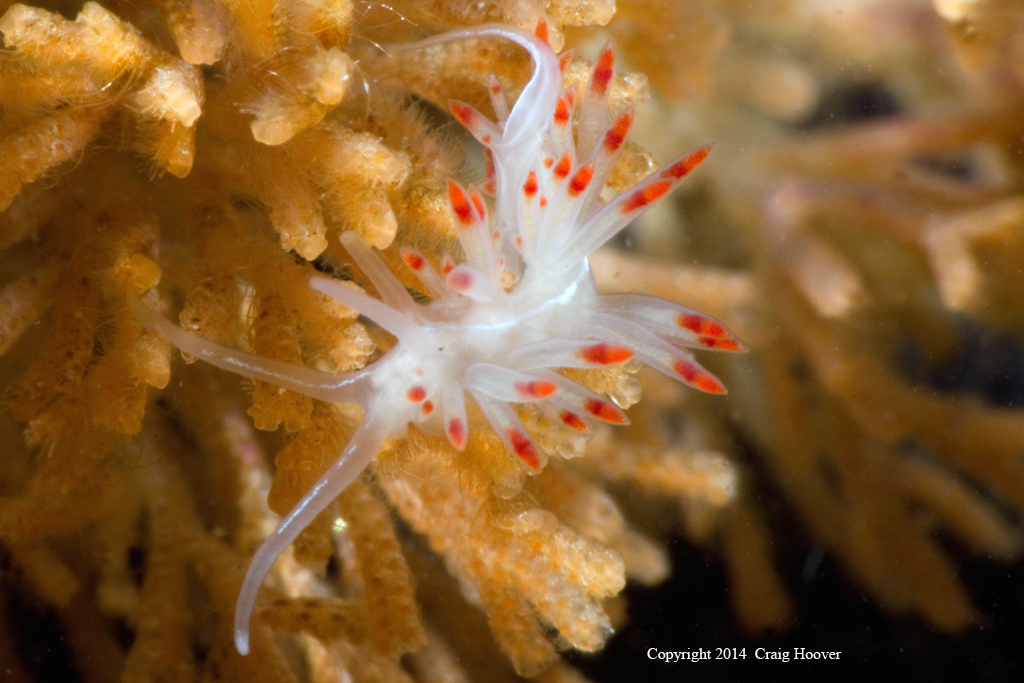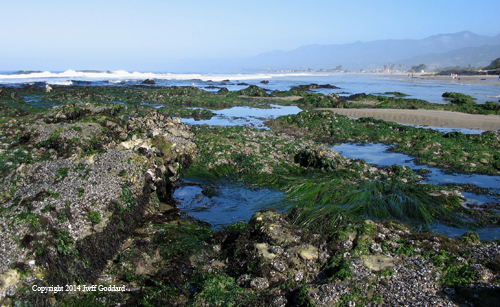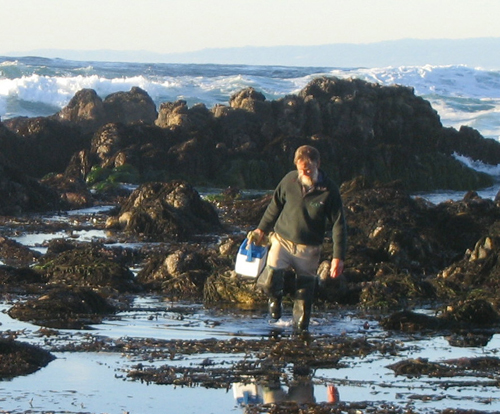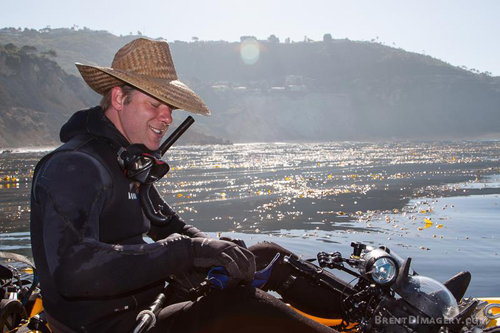 |
Flabellina goddardi
Image courtesy of Craig HooverEst size 10 mm
Las Flores Canyon in Malibu, California
Tarpits Reef
 |
Flabellina goddardi Gosliner 2010 Starting with its discovery in May 2008, Flabellina goddardi has until recently been found only at Tarpits Reef (at left), a small, low intertidal bench in Carpinteria, California. On the weekend of April 12, 2014 Craig Hoover, a dedicated 'brancher and graduate student of Angel Valdes at CalPoly Pomona, found the specimen pictured here while searching for nudibranchs on subtidal boulders in Malibu. Here are the details from Craig: "... The length of this slug was approximately one centimeter. It was located on the vertical face of a boulder in 30 feet of water at Las Flores Canyon in Malibu, a mile and a half east of the Malibu Pier. Global positioning coordinates (GPS) for the west side of the reef are 34 2.065 N and 118 37.932 W. A kelp forest a hundred yards long and parallel to shore marks this reef. The area is accessible by boat, though intrepid beach divers may hike down a streambed and through waist deep brackish water underneath a bridge to access the site. The reef is made of boulders from 1 meter to 1.5 meters in height and width with several meters of sand between each. This area may be one of the artificial reefs built by the California Department of Fish and Wildlife several decades ago. The slug was photographed on the bryozoan that it was located on. Hydroids in the area consisted of a large amount of Plumularia and a small patch of Hydractinia. The area was searched for 30 minutes. A total of 7 other species were noted at the same depth and in the same habitat, along with a large variety and quantity of opisthobranch egg masses. Of special note is that this sighting occurred two weeks after spring's seasonal peak in upwelling, a time when plankton is abundant. Photographic gear used was a Canon 7D camera with a 100mm IS lens in an Aquatica A7D housing. Lighting was provided by two YS110a strobes linked to the camera by fiber optics. A Fantasea LED44 was mounted and used as a focus light..." |
Craig's exquisite image clearly shows the smooth rhinophores, long cephalic tentacles, translucent body, and cerata with bright orange cnidosac and subapical red band characteristic of F. goddardi. Although the type specimen from 2008 lacked any white pigmentation (BOW 711), specimens image 3 found since then in Carpinteria have had varying degrees of white striping on the body, cephalic tentacles and especially the tail.
Except for the first specimen, which was found crawling on algae in a tide pool, all specimens of this species from Tarpits Reef have been found on a tangled mat image 4 of hydroids, erect bryozoans, calcareous sponges and slender colonial ascidians underneath a few small ledges \\ Image 5. Determining its hydroid prey has proved challenging, given that six species of hydroids, including an undescribed Eudendrium and other filiferans, are present and intertwined in the mat. However, microscopic examination of squashes of the nudibranch's cnidosacs and hydroid polyps revealed it to be acquiring cnidocytes from one of the two branching bougainvilliids present.
Since May 2008, a total of 18 additional specimens of F. goddardi have been found in Carpinteria, all underneath two small ledges, on the following dates: 20 May 2011 (12 specimens), 3 June 2011 (4), 20 June 2012 (1), 4 Jul 2012 (1). No specimens were found on 28 May 2013, and I did not check the site in June or July 2013. Typically, specimens are under 15 mm long, but the body and tail especially are very extensible, so that when fully extended and crawling, they can almost double in total length. The webmaster, Craig, and I would greatly appreciate hearing about new sightings of this delicate little beauty!
Jeff Goddard Tide Pooling
 |
Los Olivos, Calif May, 2014 Send Jeff email at jeff.goddard@lifesci.ucsb.edu
|
Craig Hoover on location
 |
Hi fellow branchers. My name is Craig Hoover and I am a graduate student in the lab of Dr. Angel Valdes, where I create DNA libraries to examine phylogenetic and biogeographic relations between sea slugs. I am currently researching population genetics of Felimare californiensis. I am also interested in the ecology of nudibranchs and organize local surveys in association with the American Academy of Underwater Sciences and the Pacific Explorers Dive Club to raise awareness of our local fauna. My additional interests include photography and floral biodiversity. Send Craig email at crghvr@yahoo.com |

|
